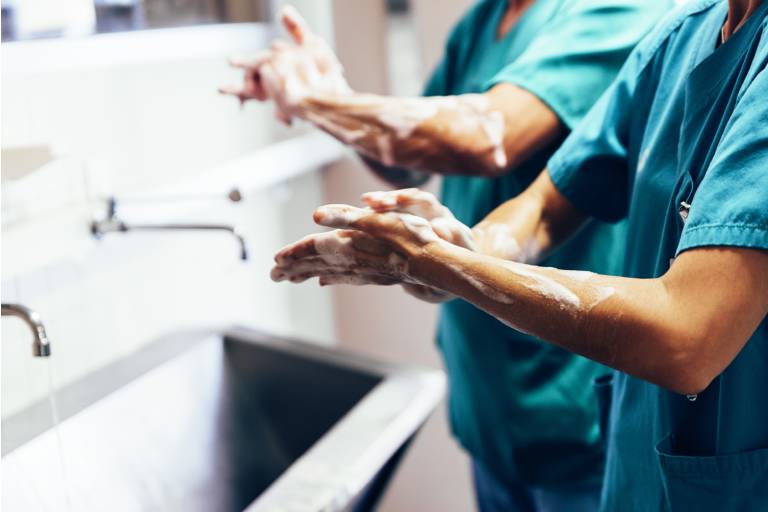Nurse Insights: What Are the Best Practices for Infection Control in Nursing?
As a registered nurse (RN) or other healthcare provider, maintaining proper infection control techniques is crucial to providing quality patient care while preventing the spread of harmful pathogens. In this article, we’ll discuss the best practices for infection control in nursing, including hygiene protocols, personal protective equipment, sterilization, and immunizations. We’ll also cover the basics of hand hygiene, including the right technique, the use of antiseptics, and key scenarios for hand hygiene practices. Let’s dive in!
Nurse Insights
What Are the Best Practices for Infection Control in Nursing?
In our Nurse Insights series, experienced nurses offer an insider’s perspective on the nursing profession by addressing common questions, challenges, and triumphs of their careers.
Understanding the Basics of Infection Control in Nursing
In nursing, maintaining proper infection control techniques is a critical aspect of patient care, as this will prevent the spread of harmful pathogens that cause diseases. This involves following strict protocols and guidelines laid down by health regulators like the Centers for Disease Control and Prevention (CDC) to ensure a safe environment for both patient and caregiver.
Hand Hygiene
Arguably one of the most important components of infection control, hand hygiene is your first line of defense against infection spread. It’s recommended that nurses thoroughly clean their hands before and after each patient interaction using soap and water or an alcohol-based hand sanitizer if soap isn’t available.
Personal Protective Equipment (PPE)
PPE is designed to protect you from exposure to infectious materials. It includes gloves, gowns, masks, respirators, goggles, and face shields, among others. Every time you’re going to come in contact with a patient, you must wear the appropriate PPE. The type of PPE you’ll wear depends on the level of precautions required for the patient’s condition. It’s essential to remove and dispose of your protective equipment according to hospital protocol to avoid contaminating yourself or others.
Sterilization and Disinfection
All medical instruments used for patient care should be appropriately sterilized or disinfected. Sterilization kills all forms of microorganisms, including bacterial spores, while disinfection eliminates many or all pathogenic microorganisms, excluding bacterial spores. Depending on the type of instrument and its use, you might use different methods of sterilization or disinfection.
Immunizations
Immunizations can help prevent the spread of diseases, both to you and to your patients. As a healthcare worker, you’re at an increased risk of exposure to certain preventable diseases, so you should keep your immunizations up to date throughout your career.
Good infection control practices are vital in nursing not only to protect yourself but also to prevent the spread of pathogens to your patients. A nurse’s role is a critical one in shaping the overall health conditions in a hospital and the broader community.
Hand Hygiene Practices
Hand hygiene is absolutely essential in the healthcare profession. As a nurse, it’s important for you to understand how this practice reduces the risk of infection and guards the health and well-being of both patients and healthcare providers alike.
The Right Technique
Proper hand hygiene isn’t simply rubbing your hands under running water. You need to use enough soap to cover all aspects of your hands and ensure a thorough scrub for a minimum of 20 seconds. Don’t overlook areas such as between fingers and under fingernails. Rinse your hands well and dry with a clean towel or air dryer to prevent recontamination from dirty faucets or surfaces.
Use of Antiseptics
Antiseptics or hand sanitizers can be highly efficient in killing most germs on your hands. The use of an antiseptic is recommended when your hands aren’t visibly soiled, when soap and water are unavailable, or where rapid hand hygiene is needed. Be sure to spread the sanitizer over the entire surface of your hands in a similar fashion to washing with soap and let your hands dry naturally.
Key Scenarios for Hand Hygiene
Good hand hygiene habits are key for all healthcare environments. Here are some occasions when you should practice hand hygiene:
- Before and after direct contact with patients.
- Before putting on and after removing gloves.
- After contact with objects in the patient’s surroundings.
- After handling bodily fluids or excretions.
- Before performing aseptic tasks such as wound care or preparing an intravenous medication.
Remember, hands are the main pathway of germ transmission during health care. Maintaining rigorous hand hygiene practices is not just a guideline, but an imperative part of the nursing role, central to ensuring patient safety.
Use of Personal Protective Equipment (PPE)
As mentioned before, there are different types of personal protective equipment (PPE) that you need to familiarize yourself with and utilize as a nurse.
Essential Types of PPE
The essential PPE in nursing includes:
- Disposable gloves: These protect your hands from germs that may reside on patients’ bodies, and also help to prevent the transmission of germs from your hands to the patient.
- Masks: Masks protect your nose and mouth from any airborne germs. There are different types to suit different needs, such as surgical masks, which shield against large droplets, and N95 masks that filter out smaller particles.
- Face shields and goggles: These are designed to protect your eyes from any infectious material that may spray into your face.
- Gowns: There are different kinds of gowns, including isolation gowns and surgical gowns, that are designed to shield your clothes and body from germs and bodily fluids.
- Shoe covers: These are designed to prevent the spread of germs from the bottom of your shoes.
How to Don and Doff PPE
It’s important to learn the correct method to put on (don) and remove (doff) your equipment to ensure maximum protection and prevent contamination.
- Donning PPE: Begin with washing your hands thoroughly, then put on your gown first. Next, put on your mask or respirator—ensure it covers your nose and mouth and is secure under your chin. If you’re using goggles or a face shield, put that on next. Finally, put on your gloves, which should cover the cuffs of your gown.
- Doffing PPE: Begin by removing your gloves, being careful not to touch the outside of the gloves with your bare hands. Then, remove your gown, turning it inside out as you do so. Next, remove your goggles or face shield. Finally, remove your mask or respirator, followed by immediate handwashing.
The incorrect use of PPE can compromise your protection and lead to contamination. Therefore, it’s essential to practice until you get it right.
Additionally, remember that PPE is the last line of defense in infection control and not a substitute for other measures such as proper hand hygiene, safe injection practices, and waste handling.
Immunizations for Healthcare Professionals
Maintaining up-to-date immunizations is crucial for nurses and other healthcare professionals. As a front-line defense against infectious diseases, you are not only at higher risk of exposure but can inadvertently transmit diseases to your patients, colleagues, and your family if you’re not adequately immunized. Immunizing healthcare personnel helps to protect vulnerable populations like the elderly, infants, or immuno-compromised patients from potential infections.
Commonly Recommended Immunizations
Here are some common immunizations that are usually recommended for healthcare personnel:
- Influenza (Flu): This is recommended annually for all healthcare personnel to reduce the likelihood of flu outbreaks in healthcare settings.
- Tdap (Tetanus, Diphtheria, Pertussis): This is recommended every 10 years to protect against these diseases, particularly the highly contagious pertussis (whooping cough).
- MMR (Measles, Mumps, Rubella): Healthcare personnel born in 1957 or after without evidence of immunity should get two doses of MMR. Those born before 1957 without evidence of immunity should get one dose.
- VAR (Varicella): If you do not have a history of chickenpox or shingles, two doses of varicella are recommended.
- Hepatitis B: This is important if you might come in contact with blood or body fluids. Three doses are typically given.
Please note that your immunization needs may vary depending on your specific role, your work environment, and any existing medical conditions. It is always best to consult with a healthcare professional or your employer’s medical team to make sure you are up to date on all necessary immunizations and that you understand the risks and benefits before consenting to receive any immunizations.
Precautions in Patient Care
In the field of nursing, you’ll be dealing with a diverse range of patients, some with communicable diseases and some without. Understanding and implementing precautions in patient care is essential for the prevention of infection transmission.
Isolation Precautions
Isolation precautions form an integral part of patient care procedures. They are used mainly with patients who are known or suspected to be infected with pathogens that can be transmitted by direct or indirect contact.
There are two types of isolation precautions:
- Contact Precautions: Used when working with patients suffering from diseases such as MRSA or C. difficile. These are generally reserved for patients who have conditions that can be spread through direct contact.
- Airborne Precautions: These are used when handling patients with diseases like tuberculosis or chickenpox, which can be spread through the air.
Always remember to properly utilize personal protective equipment, including gloves, masks, and gowns, when implementing isolation precautions.
Standard Precautions
Standard precautions are the minimum infection prevention measures that apply to all patient care, regardless of suspected or confirmed infection status of the patient, in any setting where healthcare is delivered. They include hand hygiene, use of personal protective equipment, respiratory hygiene, safe injection practices, safe handling of potentially contaminated equipment or surfaces in the patient environment, and sterile instruments and devices.
The use of standard precautions ensures that every patient is treated in a way that is safe for them and their healthcare providers. It’s important to note that which precaution to use will largely depend on the patient’s diagnosed or suspected conditions. Always consult infection control guidelines and protocols in your healthcare institution for tailored advice.
Being able to navigate through these precautions and apply them in the right circumstances is a crucial part of patient safety and care. It reduces the risk of infection transmission, ensuring a safer environment for both patients and healthcare providers.
Cleaning, Disinfection, and Sterilization
As a nurse, you must understand the procedures of cleaning, disinfection, and sterilization procedures in your healthcare setting.
Understanding the Three Steps
Cleaning, disinfection, and sterilization are three separate processes, each crucial for maintaining a safe and germ-free healthcare environment.
- Cleaning is the first step and involves physically removing dirt, organic matter, and most surface microorganisms. This process alleviates the microbial load and enhances the effectiveness of disinfectants.
- Disinfection, the second step, involves the use of chemical agents to destroy pathogenic microorganisms. However, these agents may not kill all bacterial spores, hence the necessity to follow it up with sterilization.
- Sterilization is the final step. This procedure ensures the complete destruction or removal of all forms of microbial life, including bacterial spores, and is typically accomplished using heat, chemicals, or radiation.
Each of these steps follows guidelines issued by health and safety bodies like the Centers for Disease Control and Prevention (CDC).
Guidelines to Follow
For cleaning, use clean, warm water with a high-quality detergent to physically remove dirt and reduce the number of microorganisms. Don cleaning gloves and change them when moving between different tools or surfaces.
In disinfection, follow the manufacturer’s instructions for the chosen disinfectant. It’s important to check the expiration date, correct dilution, and proper contact time of the disinfectant. Remember to be cautious when handling disinfectants, as they can be hazardous.
When you are sterilizing surfaces, it’s important to test the integrity of the sterilization process for each load. This helps ensure that the sterilization process is effective and the surfaces are properly disinfected. Additionally, it’s important to keep a record of the sterilization parameters to be accountable for the process.
There are particular guidelines for dealing with human waste, blood, and body fluids, including wearing PPE, properly containing the waste, and cleaning the surface with disinfectant.
Importance of These Procedures
These processes are vital as they prevent the spread of infections within the healthcare setting, to both patients and healthcare providers. Properly cleaned, disinfected, and sterilized medical devices aid in reducing healthcare-associated infections (HAIs).
Additionally, they ensure compliance with healthcare laws and guidelines, promoting professionalism within the industry.



